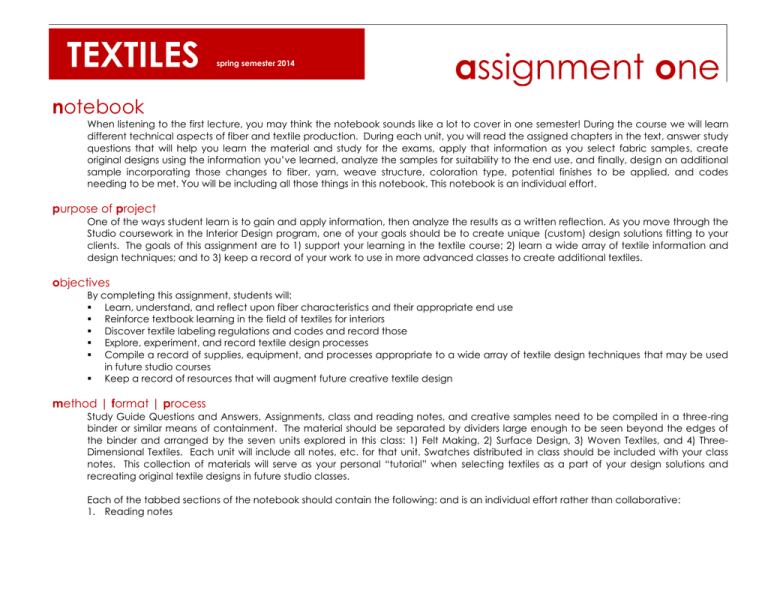Appendix File 1
advertisement

TEXTILES spring semester 2014 assignment one notebook When listening to the first lecture, you may think the notebook sounds like a lot to cover in one semester! During the course we will learn different technical aspects of fiber and textile production. During each unit, you will read the assigned chapters in the text, answer study questions that will help you learn the material and study for the exams, apply that information as you select fabric samples, create original designs using the information you’ve learned, analyze the samples for suitability to the end use, and finally, design an additional sample incorporating those changes to fiber, yarn, weave structure, coloration type, potential finishes to be applied, and codes needing to be met. You will be including all those things in this notebook. This notebook is an individual effort. purpose of project One of the ways student learn is to gain and apply information, then analyze the results as a written reflection. As you move through the Studio coursework in the Interior Design program, one of your goals should be to create unique (custom) design solutions fitting to your clients. The goals of this assignment are to 1) support your learning in the textile course; 2) learn a wide array of textile information and design techniques; and to 3) keep a record of your work to use in more advanced classes to create additional textiles. objectives By completing this assignment, students will: Learn, understand, and reflect upon fiber characteristics and their appropriate end use Reinforce textbook learning in the field of textiles for interiors Discover textile labeling regulations and codes and record those Explore, experiment, and record textile design processes Compile a record of supplies, equipment, and processes appropriate to a wide array of textile design techniques that may be used in future studio courses Keep a record of resources that will augment future creative textile design method | format | process Study Guide Questions and Answers, Assignments, class and reading notes, and creative samples need to be compiled in a three-ring binder or similar means of containment. The material should be separated by dividers large enough to be seen beyond the edges of the binder and arranged by the seven units explored in this class: 1) Felt Making, 2) Surface Design, 3) Woven Textiles, and 4) ThreeDimensional Textiles. Each unit will include all notes, etc. for that unit. Swatches distributed in class should be included with your class notes. This collection of materials will serve as your personal “tutorial” when selecting textiles as a part of your design solutions and recreating original textile designs in future studio classes. Each of the tabbed sections of the notebook should contain the following: and is an individual effort rather than collaborative: 1. Reading notes 2. Study Guide--This part is a collaborative in-class effort of a small group. 3. Help sheets posted on Blackboard for each process. These sheets will not be available to you after you complete this course, hence the need for printing and including them here. 4. A running record of electronic resources (URLs) provided to you, and discovered by you. You might want to divide this record into lists...each headed by a title such as: videos, web sites, blogs, equipment and supplies, etc. so they are more manageable. 5. Images of inspirational textiles together with the attribution in APA format. 6. Each of the 12” x 12” samples created in fulfillment of class requirements. 7. Extra samples created. 8. Reflective writing. This writing should include the following: a. Goal—what you were trying to achieve in this sample, both from a functional standpoint and intended aesthetic. For example you want to create a light-weight, drapable, residential window covering (functional goals). Additionally, you want the textile to design to be inspired by the precedents being studied in Studio and to use a small, repetitive block pattern. b. Outline of objectives used to achieve the goals…you will purchase sheer fabric of a suitable color, use a succession of block designs created with linoleum blocks ranging in size from 1” x 3” up to 4” x 4”. You will use the textile ink intended for block printing available at the bookstore. c. Listing of any changes you made as you progressed through the creation of the textile d. Photos (can be 4 to a sheet in portrait view or larger) of you making your textile sample—beginning, two during the process, and one at the end. e. Evaluation of the end product: i. Does your end product achieve your goals? Why or why not? ii. What comments regarding successes and areas for improvement were made during your critique? Do you agree with these comments? How would you address those areas for improvement? iii. What codes would need to be met if the textile were to be used as intended? Would your textile meet the necessary codes, etc., if the suggested finishes were added? iv. Evaluate the textile’s aesthetic qualities using the Principles + Elements of Design. f. Suggestions for improving this sample to reach intended goals. Focus the first paragraph on selection of fiber, yarn type, fabric structure, necessary codes, etc. The second paragraph should focus on aesthetics of hue, texture, surface design, etc. evaluation criteria Using the guidelines for grading found at the end of the syllabus, the notebook will be evaluated based on completeness of inclusions, quality and accuracy of reflections, quality of the craftsmanship throughout, and application of design. Going beyond the minimum required (including helpful but not repetitive information) will be important when determining the contents of your notebook. calendar Individual creative portions of the notebook will be collected for evaluation at the end of each unit. The completed notebook is due at the time of the final exam, Wednesday, 7 May 2014. At 10:15. They can be retrieved on Friday, 9 May, or they will be held for you until the beginning of Fall Semester.







